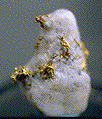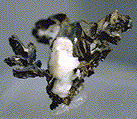

- Chemistry: Sn, elemental tin
- Class: Native Elements
- Subclass: Native Metals
- Uses: Many applications for metallic tin.
Specimens
Native tin (the latin word for tin is stannum and gives tin its chemical symbol Sn) is a rare mineral.
It is so rare that it in no way can it be thought of as an ore of tin.
Tin ore minerals include the
oxide minerals
cassiterite and
rutile and a few
sufides such as
franckeite,
cylindrite,
Pure tin metal has few uses and thus most tin is used in alloys. The most famous tin alloy is bronze. Roughly 5% tin smelted with 95% copper produces bronze. The development of bronze by primative humans was considered such an advancement that the era was called the "Bronze Age". Most solder is a combination of tin and lead. Another alloy of tin is pewter. Tin alloys had been used to make tin cans and tin roofs, but they are not used for those purposes too often now. Today, tin has significant use as a corrosion fighter in the protection of other metals and alloys and in use in the glass making industry as well as many other varied uses.
Native tin is found in placer deposits and in unusual igneous intrusions. Australia has the recognized type locality, but there is a report from Russia of an earlier find. Tin is too rare to be seen in typical rock shops, but laboratory specimens are being grown and put up for sale.
PHYSICAL CHARACTERISTICS:
- Color is white to gray.
- Luster is metallic.
- Transparency: Specimens are opaque.
- Crystal System is tetragonal (below 13.2 degrees C tin converts to isometric).
- Crystal Habits include grains in placer deposits and lab grown specimens.
- Cleavage is indistinct.
- Hardness is 1.5 - 2.
- Specific Gravity is 7.3 (heavy even for a metallic mineral).
- Streak: white - gray.
- Other Characteristics: Sectile.
- Associated Minerals include native gold,
native copper,
stistaite , native aluminum and other rare native metals. - Notable Occurrences include the type locality of Aberfoil and Sam Rivers, Oban, New South Wales and Tasmania, Australia; Miass River, Southern Urals; Amur, Yakutia; Tolbachik, Kamchatka Peninsula and Aldan Shield, Siberia, Russia.
- Best Field Indicators are color, brittleness, hardness, locality and density.







